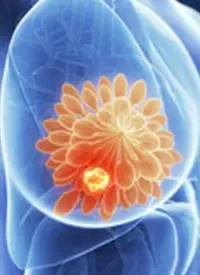MRI-Guided Neoadjuvant Chemotherapy Could be Used in HR-/HER2+ Breast Cancer
MRI-guided treatment could be used to optimize the duration of neoadjuvant chemotherapy in hormone receptor-negative/HER2-positive breast cancer.
MRI-guided treatment for duration of
neoadjuvant chemotherapy in
hormone receptor-negative
HER2-positive breast cancer

MRI guidance could be a feasible strategy to tailor the duration of neoadjuvant chemotherapy in patients with hormone receptor-negative/HER2-positive breast cancer, according to findings from the phase 2 TRAIN-3 study (NCT03820063) published in the Lancet Oncology.
In TRAIN-3, 87% (95% CI, 81%-92%) of patients with hormone receptor-negative disease (n = 233) who experienced a radiological complete response (CR) after 1 to 9 cycles of chemotherapy (n = 169) achieved a pathological CR (pCR); 88% (95% CI, 79%-94%) of patients with a radiological CR after 3 cycles (n = 84) experienced a pCR. The pCR rate was 53% (95% CI, 44%-61%) among patients with hormone receptor-positive disease (n = 232) who had a radiological CR following 1 to 9 cycles of chemotherapy (n = 138). Median follow-up was 26.4 months (IQR, 22.9-32.9) for patients with hormone receptor-negative disease and 31.6 months (IQR, 25.6-35.7) for patients with hormone receptor-positive disease.
“In our study, a third of patients with stage II–III hormone receptor-negative and HER2-positive breast cancer had a cPR after only 3 cycles of neoadjuvant systemic therapy,” Anna van der Voort, MD, of the Department of Medical Oncology at the Netherlands Cancer Institute in Amsterdam and coauthors wrote. “A CR on breast MRI could help identify early complete responders in patients who had hormone receptor negative tumors. An imaging-based strategy might limit the duration of chemotherapy in these patients, reduce [adverse] effects, and maintain quality of life if confirmed by the analysis of the 3-year event-free survival [EFS] primary end point. Better monitoring tools are needed for patients with hormone receptor-positive and HER2-positive breast cancer.”
TRAIN-3 was a non-comparative, single-arm study that enrolled patients with stage II to III HER2-positive breast cancer across 43 hospitals in the Netherlands. Eligible patients were at least 18 years old and had a WHO performance status of 1 or less, a left ventricular ejection fraction of 50% or higher, adequate organ function as established by laboratory assessment, and radiological evaluability per protocol. Patients who were pregnant, had a history of cancer less than 5 years before study entry, or previously received chemotherapy were excluded.
All patients were treated with intravenous neoadjuvant paclitaxel at a dose of 80 mg/m2 on day 1 and 8 of each 3-week cycle; trastuzumab (Herceptin) at an 8 mg/kg loading dose on day 1 of cycle 1 then 6 mg/kg on day 1 on all subsequent cycles; carboplatin at an area under the concentration time curve of 6 mg per minute per mL on day 1 of each 3-week cycle; and pertuzumab (Perjeta) at a loading dose of 840 mg on day 1 of cycle 1 then 420 mg on day 1 of each subsequent cycle. Patient response to chemotherapy was monitored by breast MRI performed every 3 cycles and lymph node biopsy. Surgery was performed when patients experienced a radiological CR or following a maximum of 9 cycles of therapy.
The primary end point was 3-year EFS rate, which will be reported in the future after 700 patient-years of follow-up. Secondary end points included pCR, radiological CR, number of neoadjuvant chemotherapy cycles administered, number of radical resections, overall survival (OS), and safety. Exploratory end points included mechanisms of resistance to treatment, whole-exome sequencing plus proteomics on pretreatment biopsies, on-treatment biopsies, residual tumors after treatment, sequential ctDNA, tumor-educated platelets, and the effect of in vivo biotransformation of trastuzumab and pertuzumab on treatment response.
At baseline, the median age of the overall population (n =467) was 51 years (IQR, 43-59). Most patients were premenopausal or perimenopausal (51%) and had clinical stage cT2 to T3 tumors (87%), node positive disease (60%), stage II disease (69%), a HER2 immunohistochemistry score of 3-plus (82%), grade III tumors (53%), and no special histology (96%).
Additional findings from the study showed that patients with hormone receptor-negative disease experienced a radiologic CR rate of 36% (95% CI, 30%-43%) following 1 to 3 cycles of chemotherapy, 60% (95% CI, 53%-66%) following 1 to 6 cycles, and 73% (95% CI, 66%-78%) following 1 to 9 cycles. These rates were 29% (95% CI, 24%-36%), 51% (95% CI, 44%-57%), 59% (95% CI, 53%-66%), respectively, in the hormone receptor-positive group. The cumulative pCR rates including patients undergoing surgery in the absence of a radiological CR, were 80% in the hormone receptor-negative group and 43% in the hormone receptor-positive group.
In terms of safety, 58% of patients in the overall population experienced a grade 3 adverse effect (AE) and 8% experienced a grade 4 AE. Among patients who received 1 to 3 cycles of chemotherapy (n = 160), the most common grade 3 AEs included neutropenia (17%), diarrhea (13%), and hypokalemia (6%); grade 4 AEs consisted of neutropenia (2%), diarrhea (1%), dehydration (1%), and cardiac chest pain (1%). Patients who underwent 4 to 6 (n = 147) and 7 to 9 (n = 160) cycles of chemotherapy experienced grade 3 AEs at a rate of 65% and 69%, respectively, and grade 4 AEs at rates of 9% and 12%, respectively.
“De-escalating chemotherapy strategies in HER2-positive breast cancer have the highest chance of success in patients with biologically HER2-driven disease. Selecting those patients upfront might therefore be a useful strategy,” study authors wrote. “In conclusion, 1 in 3 patients with stage II to III hormone receptor-negative and HER2-positive breast cancer could potentially be treated with only 3 cycles of chemotherapy. This should be confirmed by the analysis of EFS, OS, and health-related quality of life. However, breast MRI is not sufficient in hormone receptor-positive tumors, for which accurate predictive biomarkers are highly needed.”
Reference
van der Voort A, Louis FM, van Ramshorst MS, et al. MRI-guided optimisation of neoadjuvant chemotherapy duration in stage II-III HER2-positive breast cancer (TRAIN-3): a multicentre, single-arm, phase 2 study. Lancet Oncol. Published online April 5, 2024. doi:10.1016/S1470-2045(24)00104-9



